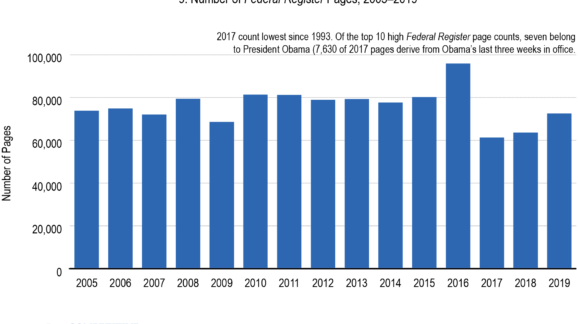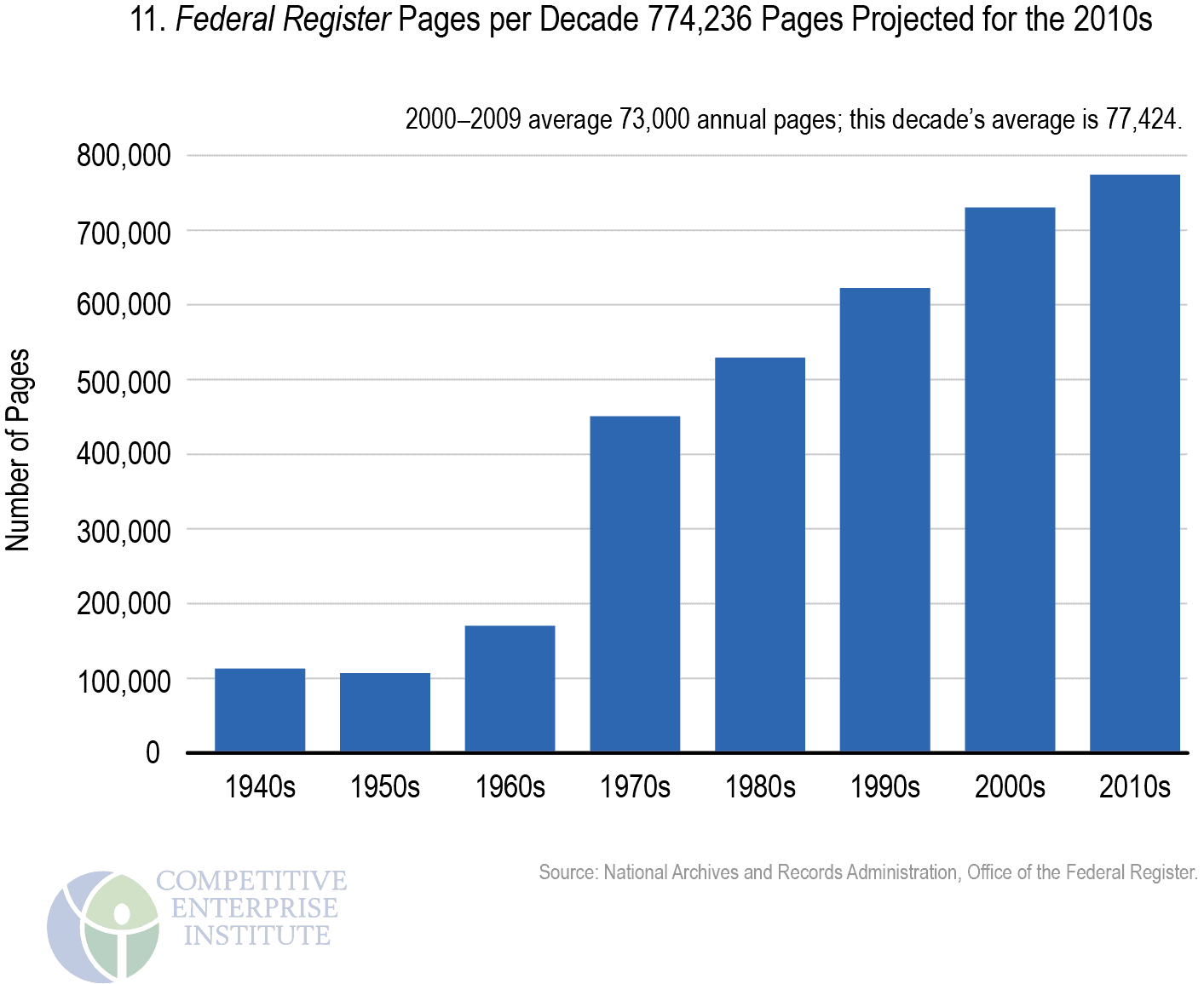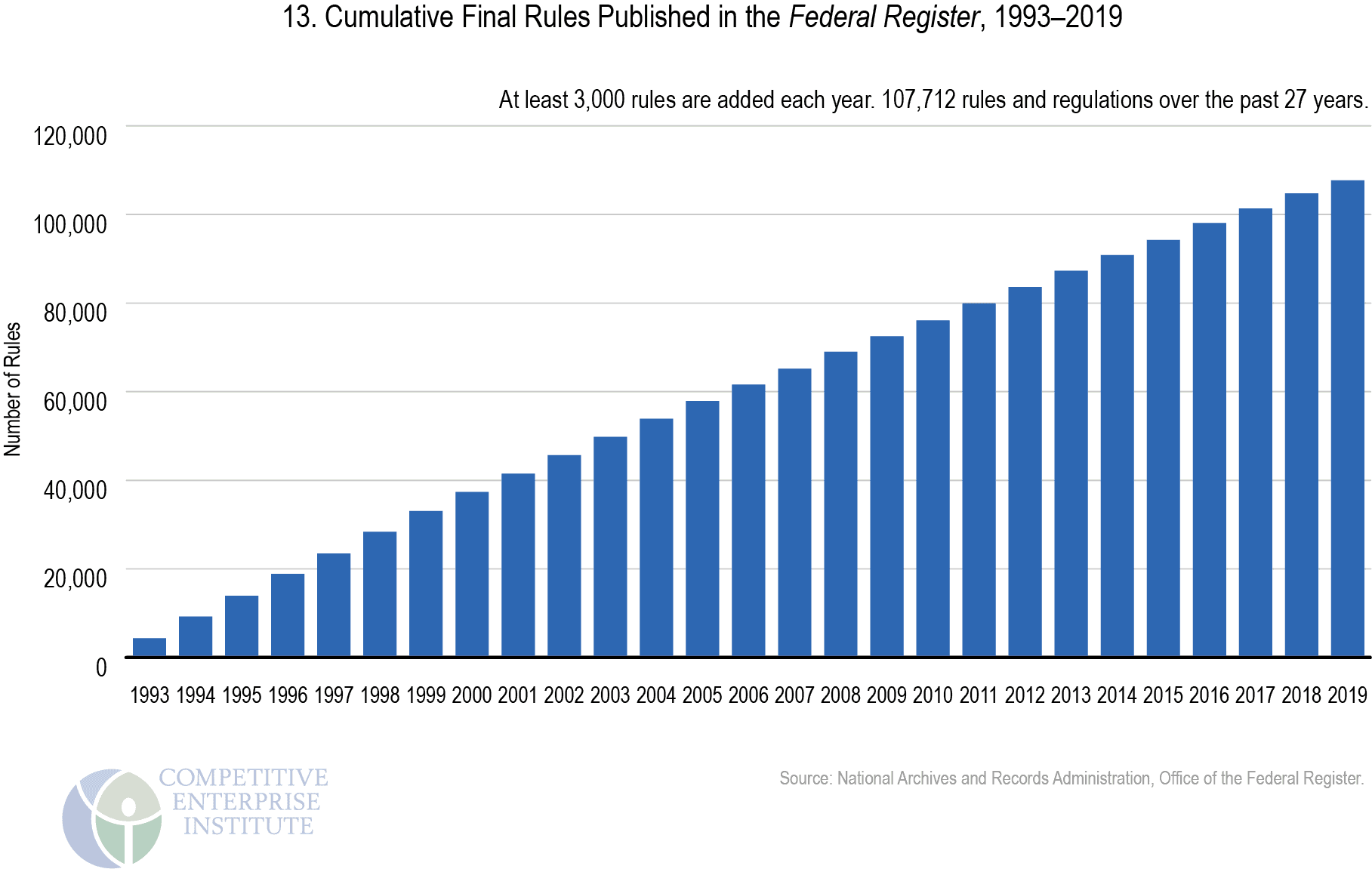Tens of Thousands of Pages and Rules in the Federal Register
Ten Thousand Commandments 2020 - Chapter 5

Download Chapter 5 as a PDF
The Federal Register is the daily repository of all proposed and final federal rules and regulations.427 Although its number of pages is often cited as a measure of regulation’s scope, there are problems with relying on page counts. A short rule may be costly and a lengthy one may be relatively cheap. The Federal Register also contains many administrative notices, corrections, rules relating to the governance of federal programs and budgets, presidential statements, and other material. They all contribute bulk and bear some relation to the flow of regulation, but they are not strictly regulations. Blank pages, skips, and corrections also affect page counts.
In previous decades, blank pages numbered into the thousands owing to the Government Publishing Office’s imperfect estimation of the number of pages that agencies would require.
In terms of Trump’s one-in, two-out agenda, one cannot easily look at the Federal Register and get a sense of what rules are being cut. Moreover, a rule that some see as deregulatory, others may see as regulatory.
Reducing regulations could make the Federal Register grow rather than shrink. While the Register has always been treated as a document cataloging regulations, it recently has chronicled their reduction, although a look at the daily Federal Register may not give that impression.
Shortcomings notwithstanding, it is worthwhile to track the Federal Register’s page counts. Preliminary data available at the time of publication will be updated in the next edition of Ten Thousand Commandments.
Federal Register Pages up 16 Percent between Trump Years One and Three
The first calendar year of the Trump administration finished with 61,308 pages in the Federal Register (see Figure 9). The last time annual page count had been that low was in 1993, at 61,166 pages under President Bill Clinton.
The 2017 count also contains three weeks of Obama administration output, however, and by the time Trump was inaugurated on January 20, 2017, the Obama administration had already added 7,630 pages to the Federal Register, making Trump’s “net” page count 53,678.428
In 2018, the Federal Register reached 67,225 pages, a 10 percent increase over Trump’s first year.429 The new 2019 count of 70,938 is 16 percent above Trump’s first year.430
By contrast with both of these, at the end of Obama’s final calendar year of 2016, the number of Federal Register pages stood at 95,854, which was the highest level in the history of the Federal Register, and a 19 percent jump over Obama’s second-to-last year’s count. Trump’s 2017 count was 36 percent below Obama’s record. The last time a drop in Federal Register page counts of the Trump magnitude happened was when Ronald Reagan reduced the count from Jimmy Carter’s 73,258 in 1980 to 44,812 by 1986, but that 28,446-page drop took five years.431
Trump’s recent 2019 count of 72,564 is still 24 percent below Obama’s record. The last time the page count was lower was back in 2009. Keep in mind that to eliminate a rule, agencies have to write a rule. So, in a perverse sense, Trump cannot shrink the Federal Register (or the number of rules), yet is still doing so.

As Figure 9 also captures, 2010 and 2011 had been the prior all-time record years, at 81,405 and 81,247, respectively. Of the 10 all-time high Federal Register page counts, seven occurred during the Obama administration. (For a history of Federal Register page totals since 1936, see Appendix: Historical Tables, Part A.)
Federal Register Pages Devoted to Final Rules
Isolating the pages devoted to final rules might be more informative than gross page counts, because it omits pages devoted to proposed rules, agency notices, corrections, and presidential documents (although those categories can have regulatory effects, too).
The final rule page count of 2018 stood at 18,182, the lowest count since 1992; the tally for 2019 rose to 20,986. Nonetheless, two things stand out in Figure 10: (a) the jump from 2015 to 2016 under Obama, when the number of pages devoted to final rules jumped by 56 percent, from 24,694 to 38,652 and (b) the drop of 51 percent from there to 18,727 pages of rules under Trump in 2017. Obama’s high was a record that shattered 2013’s then-peak of 26,417 by 46.3 percent. Trump’s 2017 count, by contrast, was the lowest seen since 1995.
While there are more relevant measures than pages to account for actual burdens, for page counts to drop so steeply between administrations is significant. Relevant to the discussion about controlling future regulatory costs are pages of proposed rules, those under production in the regulatory pipeline. These peaked at 23,193 in 2011, and Obama’s final page count of proposed rules was 21,457 in 2016. Under Trump, Federal Register pages devoted to proposed rules in 2017 were 10,892, half the level of Obama’s concluding years, and the lowest since 1981. However, these rose to 17,246 in 2018 and to 19,363 in 2019. A considerable proportion of this is presumably deregulatory activity.

Federal Register Pages Published by Decade
Still another way of looking at Federal Register trends is by pages per decade (see Figure 11). Even with Trump’s cuts late in the 2010s, a hefty jump over the prior decade materialized. The last bar of Figure 11 shows that the just-ended decade of the 2010s brought forth 774,236 pages of Federal Register, for an average of 77,424 pages per year. The prior decade had yielded 730,176 pages and an average of 73,018 pages. Even with the page count reduction during Trump’s administration, decade page counts could easily top 1 million in the 2020s, as a glance at increases since the 1940s implies.
Number of Final and Proposed Rules in the Federal Register
The slowed pace of traditional rulemaking (as opposed to Trump’s grand impulses on antitrust, trade, tech policy, family leave social policy, and other areas) is the real breakthrough. The president has issued fewer new regulations (less than 3,000) than we have seen since record keeping began in the 1970s.
In 2016, the final full year of the Obama administration, the number of final rules published in the Federal Register reached 3,853, the highest total of the Obama administration and the highest level since 2005. Under Trump, final rules dipped to 3,281 in 2017 (see Figure 12). This was the lowest count since records began being kept in the mid-1970s. Additionally, 207 rules issued in 2017 up to the point of Trump’s inauguration were Obama’s, giving Trump a “net” of 3,074 that year.432 In 2018, the rule count bumped up to 3,368, still the second lowest count.433 The 2019 tally of final rules fell to 2,964, even lower than the 2017 record despite the fact that some of the rules were deregulatory in character. The reduction may be partly attributable to the requirement for a major rule designation under the April 2019 OMB directive to agencies. The fact that records of the amount of non-congressional lawmaking were not kept until the latter half of the 1970s—three decades after the Administrative Procedure Act became law—is indicative of the problems with the out-of-control administrative state.


The number of final rules currently being published is lower than it was throughout the 1990s, when the average annual total of final regulations was 4,596. The average for the period 2000–2009 was 3,948.
Even Obama’s highest count was below those levels. Of course, not all rules are created equal, and fewer of Obama’s rules would be expected to have been devoted to rollbacks of prior initiatives, the emphasis of Trump’s one-in, two-out directive. Note again that deregulatory actions by Trump that require notice-and-comment will add to his final and proposed rule counts.
Rules deemed “significant”—a broader category than the economically significant rules typically deemed to impart $100 million in annual costs or benefits—are worth focusing on.434 Among Obama’s 3,853 final rules in 2016, 486 were deemed “significant” under Executive Order 12966, the highest count over the past two decades. While several hundred “significant” final rules each year are the norm, this has changed drastically under the Trump administration. Trump has issued 199, 108, and 66 in 2017, 2018, and 2019, respectively, the lowest levels since 2006’s 164 significant finals rules.435
As the Trump deregulatory effort has demonstrated, stopping or slowing rules in the pipeline is easier than getting rid of existing rules. On an ongoing basis as administrations change, more detailed official proposed rule analysis would be worthwhile. For example, it would be helpful for the Federal Register to clearly flag which among proposed rules are deregulatory as opposed to regulatory (something now done in the Unified Agenda).
That would allow more fruitful analysis of the routine and the significant alike among forthcoming rules, since the quantity of both significant and lesser proposed rules are a leading indicator of expanding government.
In Obama’s final year of 2016, 2,419 proposed rules appeared in the Federal Register. In Trump’s first year, the count fell to 1,834 (including the 156 proposals that had been issued by Obama during the first three weeks of 2017). Like final rules, Trump’s 2017 count represented the lowest since record keeping began. These rules stood at 2,098 in his second year and 2,131 in 2019. Back in the 1990s, far greater numbers of proposed rules appeared in the annual pipeline. (For the numbers of proposed and final rules and other documents issued in the Federal Register since 1976, see Appendix: Historical Tables, Part B.)
Cumulative Final Rules in the Federal Register
Trump’s 2019 final rule count is the only one ever below 3,000. The annual outflow of over 3,000 final rules—and often far more— has meant that 107,712 rules have been issued since 1993, when the first edition of Ten Thousand Commandments was published (see Figure 13). Going back to 1976, when the Federal Register first began itemizing them, 204,802 rules have been issued (see Historical Tables, Part B).
The Expanding Code of Federal Regulations
The page count for final general and permanent rules as they come to their final destination in the Code of Federal Regulations (CFR) is not as dramatic as the yearly count of tens of thousands for the Federal Register, but still considerable. (See Figure 14.) In 1960, the CFR contained 22,877 pages. Since 1975, its total page count has grown from 71,224 to 185,984 at the end of 2019, including the index—a 160 percent increase. The number of CFR bound volumes stands at 242, compared with 133 in 1975. (For the detailed breakdown numbers of pages and volumes in the CFR since 1975, see Appendix: Historical Tables, Part C.)
As noted, in recent years, traditional rules and regulations have been overshadowed in part by various forms of executive actions and regulatory guidance documents, which are important to track as well. There is no CFR-style repository for these, but Trump’s Executive Order 13981, “Promoting the Rule of Law through Improved Agency Guidance Documents,” will begin the process of an inventory during 2020.

